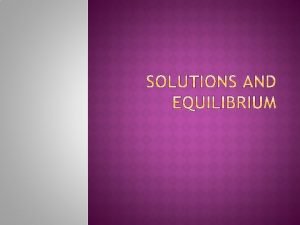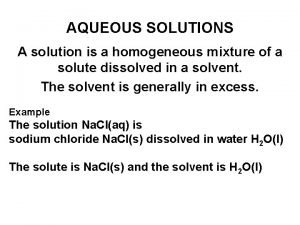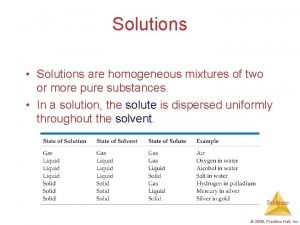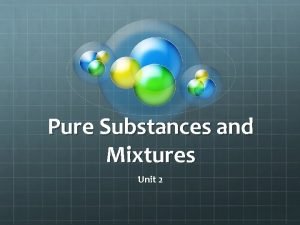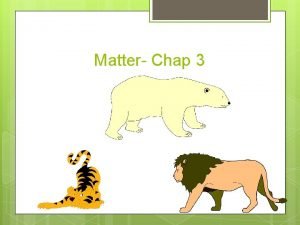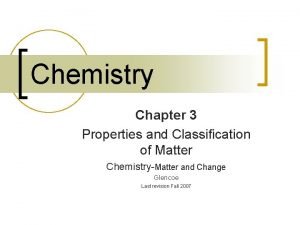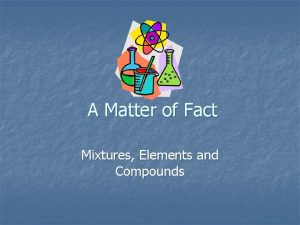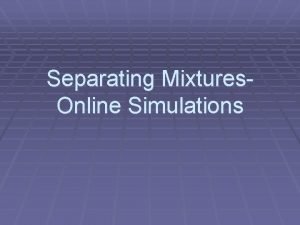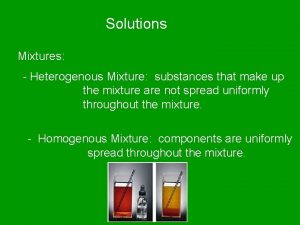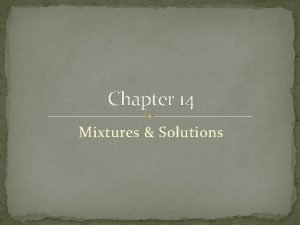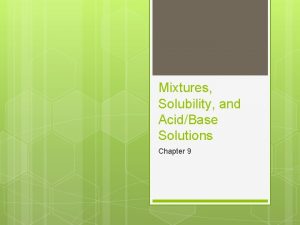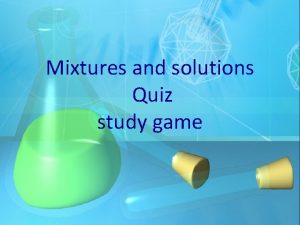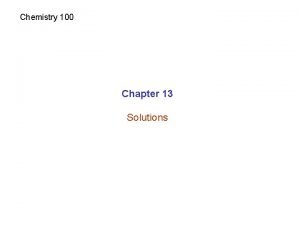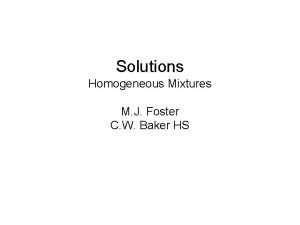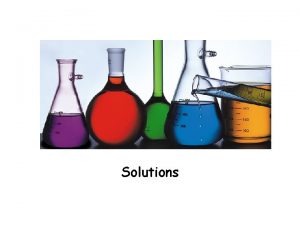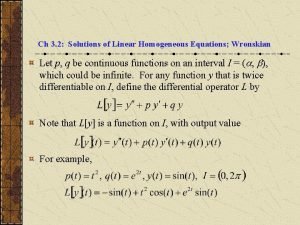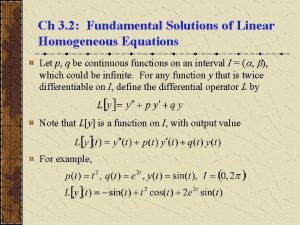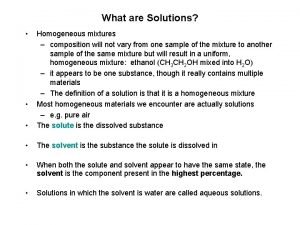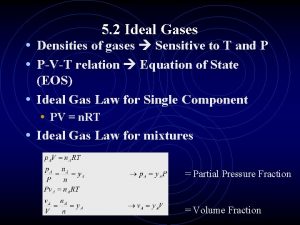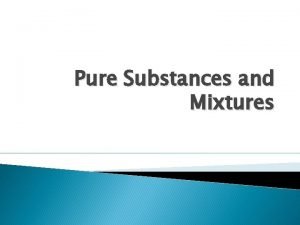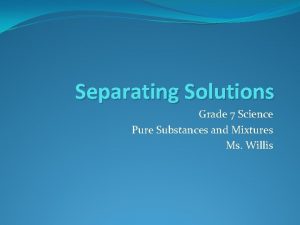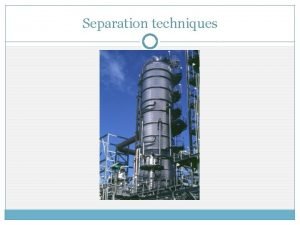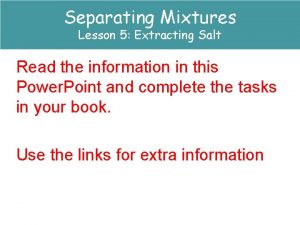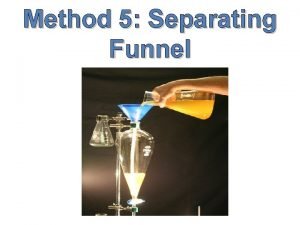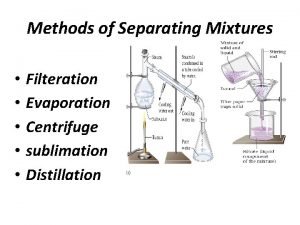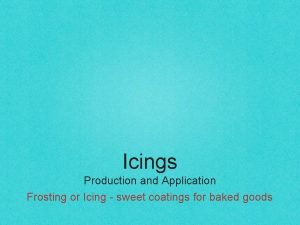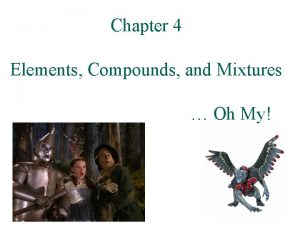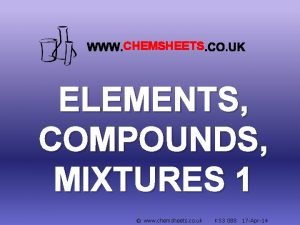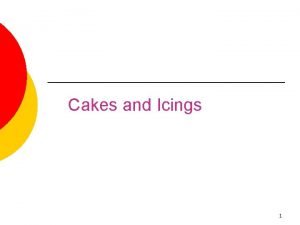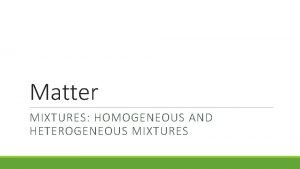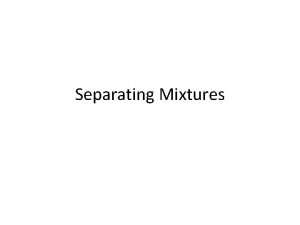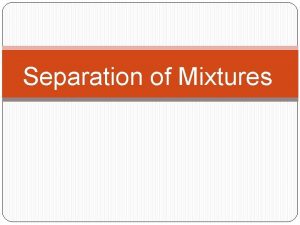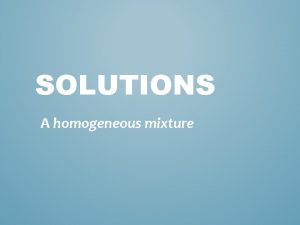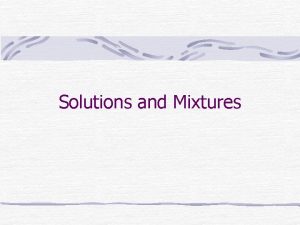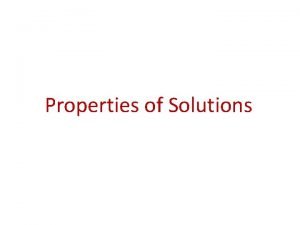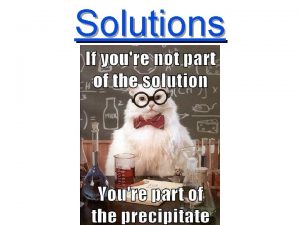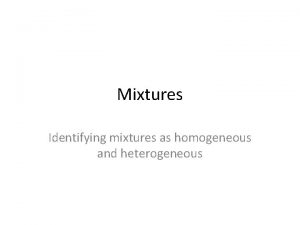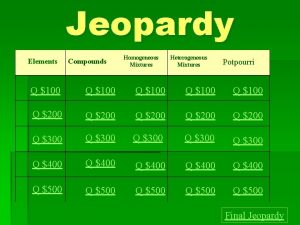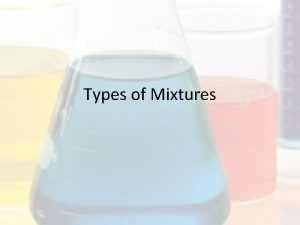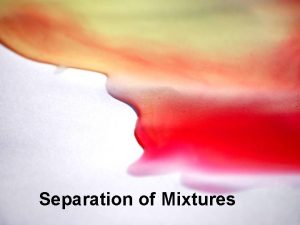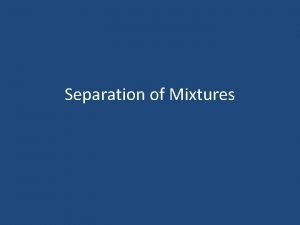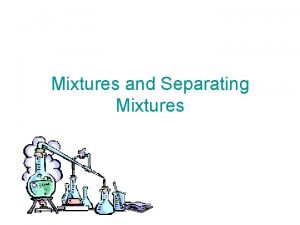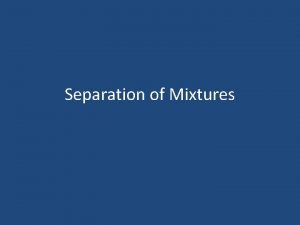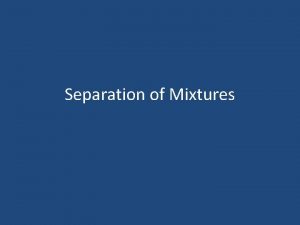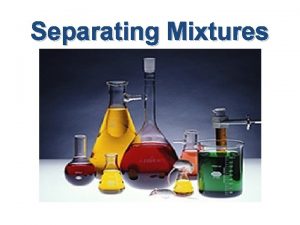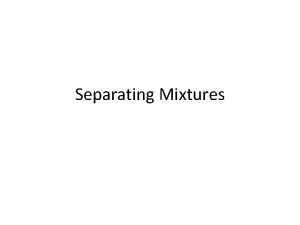Solutions Solutions Homogeneous mixtures evenly mixed Solutions Homogeneous















































- Slides: 47

Solutions

Solutions Homogeneous mixtures (evenly mixed)

Solutions Homogeneous mixtures (evenly mixed) Made of a solute dissolved in a solvent.

Solutions Homogeneous mixtures (evenly mixed) Made of a solute dissolved in a solvent. Can be liquid (salt water), gas (air), or solid (alloy)

Describing Concentration

Describing Concentration Qualitative ways of describing concentration:

Describing Concentration Qualitative ways of describing concentration: Very general descriptions:

Describing Concentration Qualitative ways of describing concentration: Very general descriptions: Dilute: a small amount of solute is dissolved

Describing Concentration Qualitative ways of describing concentration: Very general descriptions: Dilute: a small amount of solute is dissolved Concentrated: a large amount of solute is dissolved

Describing Concentration Qualitative ways of describing concentration: Very general descriptions: Dilute: a small amount of solute is dissolved Concentrated: a large amount of solute is dissolved More specific descriptions based on saturation:

Describing Concentration Qualitative ways of describing concentration: Very general descriptions: Dilute: a small amount of solute is dissolved Concentrated: a large amount of solute is dissolved More specific descriptions based on saturation: Unsaturated: more can dissolve

Describing Concentration Qualitative ways of describing concentration: Very general descriptions: Dilute: a small amount of solute is dissolved Concentrated: a large amount of solute is dissolved More specific descriptions based on saturation: Unsaturated: more can dissolve Saturated: no more can dissolve at that temperature

Describing Concentration Qualitative ways of describing concentration: Very general descriptions: Dilute: a small amount of solute is dissolved Concentrated: a large amount of solute is dissolved More specific descriptions based on saturation: Unsaturated: more can dissolve Saturated: no more can dissolve at that temperature Super-saturated: more is dissolve than normally possible at that temperature (very unstable condition).

Solution simulation. jar

Describing Concentration Quantitative way of describing concentration:

Describing Concentration Quantitative way of describing concentration: Molarity

Describing Concentration Quantitative way of describing concentration: Molarity Moles of solute per liter of solution

Describing Concentration Quantitative way of describing concentration: Molarity Moles of solute per liter of solution To calculate: # of moles divided by # of litter

Describing Concentration Quantitative way of describing concentration: Molarity Moles of solute per liter of solution To calculate: # of moles divided by # of litter Unit: M (for molar) -- upper case and in italics or underlined

Describing Concentration Quantitative way of describing concentration: Molarity Moles of solute per liter of solution To calculate: # of moles divided by # of litter Unit: M (for molar) -- upper case and in italics or underlined There are many other, less common ways



Solutions Vocabulary. pptx


Solubility: Factors affecting dissolving ability

Solubility: Factors affecting dissolving ability Polarity

Solubility: Factors affecting dissolving ability Polarity polar dissolve in polar; non-polar in non-polar

Solubility: Factors affecting dissolving ability Polarity polar dissolve in polar; non-polar in non-polar Temperature

Solubility: Factors affecting dissolving ability Polarity polar dissolve in polar; non-polar in non-polar Temperature Solids are more soluble in water as temperature increases

Solubility: Factors affecting dissolving ability Polarity polar dissolve in polar; non-polar in non-polar Temperature Solids are more soluble in water as temperature increases Gases are less soluble in water as temperature increases

Solubility: Factors affecting dissolving ability Polarity polar dissolve in polar; non-polar in non-polar Temperature Solids are more soluble in water as temperature increases Gases are less soluble in water as temperature increases Pressure

Solubility: Factors affecting dissolving ability Polarity polar dissolve in polar; non-polar in non-polar Temperature Solids are more soluble in water as temperature increases Gases are less soluble in water as temperature increases Pressure Solids and liquids: solubilities aren't affected by pressure.

Solubility: Factors affecting dissolving ability Polarity polar dissolve in polar; non-polar in non-polar Temperature Solids are more soluble in water as temperature increases Gases are less soluble in water as temperature increases Pressure Solids and liquids: solubilities aren't affected by pressure. Gases: more soluble in water as pressure increases.

Solubility: How solutes dissolve

Solubility: How solutes dissolve Solvation

Solubility: How solutes dissolve Solvation Individual atoms, ions, or molecules are surrounded by solvent molecules and brought into solution.

Solubility: How solutes dissolve Solvation Individual atoms, ions, or molecules are surrounded by solvent molecules and brought into solution. When water is the solvent, the process is called hydration.

Solubility: How solutes dissolve Solvation Individual atoms, ions, or molecules are surrounded by solvent molecules and brought into solution. When water is the solvent, the process is called hydration. Dissociation

Solubility: How solutes dissolve Solvation Individual atoms, ions, or molecules are surrounded by solvent molecules and brought into solution. When water is the solvent, the process is called hydration. Dissociation The breaking up of an ionic compound into ions during solvation or hydration.

H H O O H O H H H O H H O Na+ Cl- Na+ Cl- Na+

H O O H H O O H H H O Na+ Cl- Na+ Cl- Na+ H H O H H H

O H O Na+ Cl. Cl- Na+ O Na+ H H H O Na+ H O H H O Cl- O H H O O H H H O H

H H O Na+ Cl. Cl- Na+ O H H H H O Na+ H O H Na+ O Cl. H O O H O H H H H

H O O O Na+ Cl- Na+ Cl. Cl- Na+ H H H H O H H H Na+ O H O H H H O Cl- H O H Cl- H H H O Na+ O H H H O H

Solutions In Class Review. pptx


Attachments Solution simulation. jar Solutions Vocabulary. pptx Solutions In Class Review. pptx
 Are all solutions homogeneous mixtures
Are all solutions homogeneous mixtures Are aqueous solutions homogeneous mixtures
Are aqueous solutions homogeneous mixtures Are aqueous solutions homogeneous mixtures
Are aqueous solutions homogeneous mixtures Are solutions homogeneous
Are solutions homogeneous Mixture
Mixture Homogeneous mixtures examples
Homogeneous mixtures examples Common homogeneous mixtures
Common homogeneous mixtures Facts about mixtures
Facts about mixtures Application of homogeneous differential equation
Application of homogeneous differential equation Complementary colors examples
Complementary colors examples A smooth texture reflects light evenly
A smooth texture reflects light evenly Qualtrics advanced randomization
Qualtrics advanced randomization Tilapia market form
Tilapia market form Separating mixtures fossweb
Separating mixtures fossweb Solutions are heterogenous mixtures
Solutions are heterogenous mixtures Chapter 14 mixtures and solutions worksheet answers
Chapter 14 mixtures and solutions worksheet answers Chemistry homogeneous mixture
Chemistry homogeneous mixture Mixtures solubility and acid/base solutions answer key
Mixtures solubility and acid/base solutions answer key Mixtures and solutions quiz
Mixtures and solutions quiz Mixture vs solution
Mixture vs solution Element molecule compound mixture worksheet
Element molecule compound mixture worksheet Grade 6 term 2 natural science
Grade 6 term 2 natural science Chapter 13 solutions chemistry
Chapter 13 solutions chemistry Heterogeneous mixture def
Heterogeneous mixture def Solution is a homogeneous mixture
Solution is a homogeneous mixture Are solutions homogeneous
Are solutions homogeneous Fundamental solutions of linear homogeneous equations
Fundamental solutions of linear homogeneous equations Fundamental solutions of linear homogeneous equations
Fundamental solutions of linear homogeneous equations Gaseous solution
Gaseous solution Kay's mixing rule
Kay's mixing rule A substance
A substance Distillation grade 7
Distillation grade 7 Objectives in separating mixtures
Objectives in separating mixtures Separating mixtures worksheet grade 5
Separating mixtures worksheet grade 5 A separating funnel is used to separate
A separating funnel is used to separate Compounds vs mixtures
Compounds vs mixtures Properties of mixtures
Properties of mixtures Centrifuge separating mixtures
Centrifuge separating mixtures Buttercream icings are light smooth mixtures of
Buttercream icings are light smooth mixtures of Can sulfur and water be separated by filtration
Can sulfur and water be separated by filtration Substances and mixtures
Substances and mixtures Elements compounds and mixtures oh my
Elements compounds and mixtures oh my Www.chemsheets
Www.chemsheets Separation techniques gcse
Separation techniques gcse Stirring utensil that will not conduct heat as you stir!
Stirring utensil that will not conduct heat as you stir! Buttercream icings are light smooth mixtures of
Buttercream icings are light smooth mixtures of Lightweight concrete mix ratio
Lightweight concrete mix ratio 14. separating mixtures of liquids.
14. separating mixtures of liquids.
